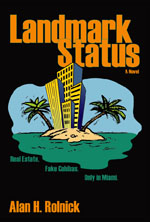There Goes the Neighborhood
Posted on 06.03.08 12:57AM under The Everglades Room
Football fans everywhere knew the Orange Bowl. Some even knew it was built in 1937, that the Dolphins called it home during their perfect 1972 season, and that the Miami Hurricanes, its only continuous tenants, just moved to the Dolphins’ newer stadium uptown, twelve years after its eponymous bowl game moved there. Watching televised games, you might have wondered what kind of two-bit burg would put up the chintzy “The City of Miami Welcomes You” sign that ringed the upper deck, looking for all the world like it was hand-painted in a garage for a fifth-grade art project. The answer, of course, is the poorest city in the land, where the most valuable asset is dirt.
If you ever visited, you probably remember your host “fighting his way to the Orange Bowl on big game days through choking traffic, past parking lots that had never been built, in search of a ‘forty dollar no block’ in somebody’s front yard,” like lawyer Benjy Bluestone in my novel Landmark Status. But unless you were there, you wouldn’t know just how primitive the Orange Bowl really was, with amenities so crude they mocked the very concept. Like Miami in general, the OB was not user-friendly, as newcomers like Delia Torres learned soon after arrival:
“You had to really want to see a game to see it at the Orange Bowl, decided Delia. It was a poor excuse for a stadium — rickety, dirty and dingy like no arena she’d ever seen. And God forbid you had to go to the bathroom there. Everybody stood up to pee at the OB.”
Ah, but for Hurricanes fans – even fictitious ones like Delia, or Benjy’s client, Walter Marsh – the OB was a temple, a shrine, a rattling steel cage where opponents’ seasons came to die after a deafening welcome to the jungle during pre-game warmups:
“Walter was headed home after a rare Wednesday night Hurricanes game against the Rattlers of Florida A & M, squeezed into the schedule at the last minute, after an opponent canceled. Non-conference teams that didn’t have to play the Canes often had second thoughts about going through with it. Some simply ran away screaming, like long-term rival Notre Dame did in the late eighties.”
But let’s get serious. This is Miami, a city built by hustlers, with part-time politicians who need to make a living, and a real estate bubble that recently popped enough projected tax money to gift them an even bigger playpen than the airport. Despite the opulence and fabulousness of those who’ve traditionally brought their money here to keep it away from tax collectors and spouses, this is a place where the city fathers and mothers never do much more than lift a finger to keep the poor from getting poorer.
And lifting a finger is exactly what they did this time. With visions of sugar plum contracts dancing in their heads, their Christmas present to themselves was a plan to raid “community redevelopment” funds set aside for impoverished neighborhoods nowhere near the Orange Bowl, and bury it under a half-billion dollar baseball stadium filled with sweet construction and concession contracts. The icing on their three-billion-dollar cake was a breathtakingly expensive tunnel under Biscayne Bay to connect the port to the interstate (instead of the highway that already does). And the best part? Nobody got to vote on it.
Naturally, there was litigation, from a luxury car magnate who may have had a personal motive in resisting the shoehorning of a trolley line (the lipstick on this pig) into narrow city streets near his dealership. But give him credit. He bankrolled the fight to stop robbing the poor to give to the rich (like the owners of the Marlins, one of baseball’s worst-drawing teams). None of it mattered. The last bits of scrap are being hauled away, and only the scoreboard remains.
With blistering sun and heat so wet you wore it, the Orange Bowl sucked the life out of Hurricanes opponents through five championship seasons and countless legendary games. It gave us the ritual of running through the smoke and holding up four fingers at the end of the third quarter, because Miami’s ballin’ boys owned the fourth. Home of the swagger, the speed, the fatigues, the bang-bang scoring drives that took thirty seconds, the OB always promised to rock you like a hurricane, and rock it did when the faithful would stomp on its shaky chassis, sending tremors down to the field where no visitor won a game from 1985 to 1994.
And it’s all over. The Canes are gone, after seventy seasons, and so is their home field. Unlike some other buildings with dubious historic claims (like Walter’s bar in Landmark Status), this place was the real deal. Now, like Tiger Stadium, The Polo Grounds or (insert name of favorite demolished stadium here), the Orange Bowl will pass into legend, living on only in stories told by those who were there when seventy-five thousand stomping pairs of feet made it shake so hard you were sure it was about to collapse, a hallowed pile of rust standing proud through it all, until a terminal case of developer’s fever brought it down.
* * *
Alan H. Rolnick has practiced law in Miami for twenty years and has appeared in numerous high-profile cases. His first novel, Landmark Status, received such ecstatic reviews he wondered if his publicist had scandalous pictures of the reviewers in her safe. Alan consults on legal matters for the entertainment industry, provides trenchant social commentary in any medium, and is Executive Producer of the independent film Canvas. To learn more, visit www.alanrolnick.com or e-mail alan@alanrolnick.com.

Post Comments
XHTML allowed: <a href="" title=""> <abbr title=""> <acronym title=""> <b> <blockquote cite=""> <cite> <code> <del datetime=""> <em> <i> <q cite=""> <strike> <strong>
* Required. Your email will never be displayed in public.
